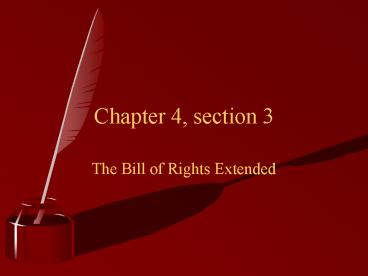Chapter 4, section 3 PowerPoint PPT Presentation
1 / 13
Title: Chapter 4, section 3
1
Chapter 4, section 3
- The Bill of Rights Extended
2
Warm-up
- Go to p.80 in your text. Briefly read the 13th
(XIII) amendment. Now go to p.81, briefly read
the 14th (XIV) amendment. Now go to p.82, briefly
read the 15th amendment. - Now answer the following question with a brief
paragraph - What was the significance of these amendments
after the Civil War? - What is the significance of these amendments
today?
3
Vocabulary
- Suffrage -
- the right to vote
- poll tax -
- a sum of money paid in exchange for the right to
vote
4
Equality for all????
- When the Constitution and Bill of Rights was
created its rights and liberties did not apply to
all Americans - Women could not vote and were considered
second-class citizens - African-American Men could not vote until 1870
and even then they experienced great difficulty,
particularly in the South. - Why????
5
1.) Civil War Amendments
- The Thirteenth Amendment (1865)
- Officially ended slavery
- The Fourteenth Amendment (1868)
- required every state to grant its citizens equal
protection of the laws - forbids state governments from interfering with
rights and privileges of U.S. citizens
6
Civil War Amendments
- The Fifteenth Amendment (1870)
- Extended rights of African-American men by
granting them the right to vote.
The First Colored Senator and Representatives, in
the 41st and 42nd Congress of the United
States.Washington Currier Ives, 1872.Color
lithograph.
7
2.) Voting Rights Elections
- The Seventeenth Amendment (1913)
- allowed voters to directly elect their Senators
8
2.) Voting Rights Elections
- The Nineteenth Amendment (1920)
- finally gave women the right to vote
- Suffragists like Susan B. Anthony and Elizabeth
Cady Stanton struggled to win the right to vote!
9
2.) Voting Rights Elections
- The Twenty-third Amendment (1961)
- granted residents of the District of Columbia the
right to vote for President and Vice President
10
2.) Voting Rights Elections
- The Twenty-fourth Amendment (1964)
- made poll taxes illegal in national elections
In the South, two thirds of the voting population
are barred from the polls by a head tax which is
a prerequisite to voting. What this "one third
democracy for one sixth of the nation" means to
the Democratic party, to the nation, and to the
issues of the 1940 elections are revealed in the
staggering facts and figures here presented in
the first of two articles by a young southern
writer.
11
2.) Voting Rights Elections
- The Twenty-sixth Amendment (1971)
- lowered the minimum voting age from 21 to 18
years of age in all national, state, and local
elections - Jennings Randolph"Father of the 26th Amendment"
"The Father of the 26th Amendment" introduced
legislation eleven times -- in the U.S. House of
Representatives and later in the United States
Senate -- to lower the voting age, beginning in
1942 until its passage in 1971. Due to his
persistence, 18-20-year-olds have had the
opportunity to vote in eight presidential
elections.
12
Section 3 Review
- 1. What are the provisions of the three Civil War
amendments? - Answer the 13th abolished slavery, the 14th
granted all citizens equal protection, the 15th
granted African -American men the right to vote - 2.) What five other amendments concern voting
rights and elections? - Answer amendments 17, 19, 23, 24,26
13
Close
- Should equal protection of the laws extend to all
U.S. citizens automatically or only those who are
law-abiding and hardworking? - Explain your opinion in a well-organized
paragraph with a topic sentence, 2 to 3
supporting details and a conclusion.

